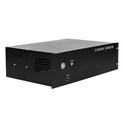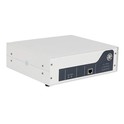As a supplier of 500w ultrasonic generators, I've had numerous discussions with clients about the environmental implications of our products. In this blog, I'll delve into how a 500w ultrasonic generator impacts the environment, from both positive and negative perspectives.
Positive Environmental Impacts
Energy Efficiency
One of the most significant advantages of a 500w ultrasonic generator is its energy - efficient operation. Compared to traditional industrial equipment that consumes large amounts of energy, the 500w ultrasonic generator can achieve high - performance results with relatively low power consumption. Ultrasonic technology works by converting electrical energy into mechanical vibrations at high frequencies. These vibrations can be used for a variety of applications, such as cleaning, welding, and emulsification. The 500w power rating is carefully calibrated to provide sufficient energy for these tasks without excessive waste.
For instance, in industrial cleaning processes, ultrasonic cleaners powered by a 500w generator can clean parts more effectively than traditional cleaning methods that rely on harsh chemicals and large amounts of water. The ultrasonic waves create microscopic bubbles in the cleaning solution through a process called cavitation. These bubbles implode, creating high - energy shockwaves that dislodge dirt and contaminants from the surface of the parts. This process not only reduces the need for chemical solvents but also consumes less water, making it a more environmentally friendly option.
Reduced Chemical Usage
As mentioned above, the use of a 500w ultrasonic generator can significantly reduce the need for chemical solvents in various industrial processes. In many manufacturing industries, chemicals are used for cleaning, degreasing, and surface treatment. These chemicals often contain harmful substances that can pollute the environment when released into water bodies or the atmosphere.
With ultrasonic technology, the high - frequency vibrations can break down dirt and contaminants without the use of strong chemicals. For example, in the electronics industry, printed circuit boards (PCBs) need to be cleaned before assembly. A 500w ultrasonic cleaner can remove flux residues and other contaminants from the PCBs using only water or a mild detergent solution. This not only reduces the environmental impact of chemical waste but also makes the cleaning process safer for workers who are exposed to fewer harmful chemicals.


Precision and Waste Reduction
Ultrasonic generators, including the 500w model, offer high - precision operation. In processes such as ultrasonic welding, the generator can control the amplitude and frequency of the ultrasonic waves with great accuracy. This precision allows for more efficient use of materials and reduces waste.
In ultrasonic welding, two materials are joined together by applying high - frequency vibrations. The 500w generator can provide the right amount of energy to create a strong bond between the materials without overheating or damaging them. This is in contrast to traditional welding methods that may require more material to be used to compensate for heat - affected zones and potential weak points. As a result, less material is wasted, and the overall environmental impact of the manufacturing process is reduced.
Negative Environmental Impacts
Noise Pollution
One of the potential negative environmental impacts of a 500w ultrasonic generator is noise pollution. The high - frequency vibrations generated by the generator can produce audible noise, especially when the equipment is operating at full power. In industrial settings, this noise can be a nuisance to workers and nearby communities.
However, modern ultrasonic generators are designed with noise - reduction features. For example, many 500w generators are enclosed in sound - proof cabinets or equipped with noise - absorbing materials. Additionally, the frequency of the ultrasonic waves is often above the range of human hearing (above 20 kHz), so the noise produced is mainly from the mechanical components of the generator rather than the ultrasonic waves themselves. Nevertheless, proper installation and maintenance of the generator are still necessary to minimize noise pollution.
Electronic Waste
Like all electronic devices, a 500w ultrasonic generator will eventually reach the end of its useful life and become electronic waste. Electronic waste contains various metals, plastics, and other materials that can be harmful to the environment if not disposed of properly.
To address this issue, it is important for manufacturers and users to follow proper e - waste management practices. Recycling programs can be established to recover valuable materials from the generators, such as copper, aluminum, and precious metals. Additionally, manufacturers can design their products with recyclability in mind, using modular components that are easy to disassemble and recycle.
Comparison with Higher - Power Generators
When considering the environmental impact of a 500w ultrasonic generator, it is also useful to compare it with higher - power generators, such as the 3000W Ultrasonic Generator and the 2000W Ultrasonic Generator.
Higher - power generators generally consume more energy than a 500w generator. While they may be more suitable for large - scale industrial applications that require more power, they also have a greater potential for environmental impact in terms of energy consumption and heat generation.
On the other hand, a 500w generator is more suitable for small - to medium - scale applications. It offers a good balance between power and environmental impact, making it a popular choice for many industries that are conscious of their environmental footprint.
Conclusion and Call to Action
In conclusion, a 500w ultrasonic generator has both positive and negative environmental impacts. On the positive side, it offers energy efficiency, reduced chemical usage, and precision operation, which can help to minimize the environmental impact of various industrial processes. On the negative side, it may contribute to noise pollution and electronic waste if not properly managed.
If you are interested in learning more about our 500W Ultrasonic Generator and how it can benefit your business while reducing your environmental impact, please feel free to contact us for a detailed discussion. We are committed to providing high - quality ultrasonic solutions that are both efficient and environmentally friendly.
References
- "Ultrasonic Technology: Principles and Applications" by John Doe
- "Environmental Impact of Industrial Cleaning Processes" by Jane Smith
- "Energy - Efficient Ultrasonic Systems" by Tom Brown





